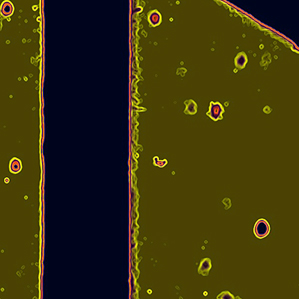Tiny Sensors Could Give an Atom-Level View of Proteins
Two reports published online in Science on Thursday open up the possibility that researchers may be able to determine the structure of individual proteins in living cells. Although the work is still in early stages, the potential is that researchers could get a better handle on the role of proteins in disease.

Physicists in the U.S. and Germany report important steps toward magnetic resonance imaging, or MRI, of molecules in two separate studies. In both reports, the researchers show how specially modified diamond flakes can be used as nanoscale magnetic field detectors. These tiny sensors can elucidate the structure of single organic molecules. With nanoscale MRI, researchers may one day be able to directly image proteins and other molecules at the atomic scale.
“If you can see on single molecule scale what is going on, and understand more details about what is happening, you may be able to find exactly what the problem is and target it specifically,” says Texas A&M University electrical engineer Philip Hemmer, who was not involved in the study but wrote a perspective on the work for the same issue of Science.
Currently, researchers have limited tools to study the molecular structure of proteins. X-ray diffraction can give them an atomic-level view of some proteins, but many copies of the protein must be crystallized into a rigid lattice, a process that does not work for all proteins and results in an averaging of protein shape. Conventional MRI, which can be used by doctors to peek inside the body, doesn’t let researchers see anything smaller than a few micrometers in size because the detectors aren’t sensitive enough to pick up magnetic field signals from very small structures. The authors of one of this week’s studies, led by Daniel Rugar, manager of nanoscale studies for IBM Research, had previously reported a method to study single molecules at the nanometer level, but that technique required ultra-cold cryogenic conditions, which precludes studies on living cells.
To develop a method that works at ambient temperatures with single, unmodified molecules, Rugar’s team, as well as a group based Stuttgart, Germany, takes advantage of defects in flakes of diamond that behave as tiny magnetic field sensors. The teams show that they can detect atomic sizes as small as five nanometers. Both groups examined a plastic-like organic polymer called PMMA, and the Germany-based team also looked at molecules within oils and other liquids.
Friedemann Reinhard, a coauthor on the Germany-based study, says that today’s results are a step toward a new technique that could determine the three-dimensional structure of a specific protein, perhaps even while it acts in a larger biological structure. Such studies could help identify differences in proteins, including spotting misbehaving proteins that might be implicated in triggering disease. Indeed, directly seeing the structure of a single protein has long been a dream of biologists. Says Reinhard: “It finally might be feasible.”
Keep Reading
Most Popular
Large language models can do jaw-dropping things. But nobody knows exactly why.
And that's a problem. Figuring it out is one of the biggest scientific puzzles of our time and a crucial step towards controlling more powerful future models.
How scientists traced a mysterious covid case back to six toilets
When wastewater surveillance turns into a hunt for a single infected individual, the ethics get tricky.
The problem with plug-in hybrids? Their drivers.
Plug-in hybrids are often sold as a transition to EVs, but new data from Europe shows we’re still underestimating the emissions they produce.
Stay connected
Get the latest updates from
MIT Technology Review
Discover special offers, top stories, upcoming events, and more.